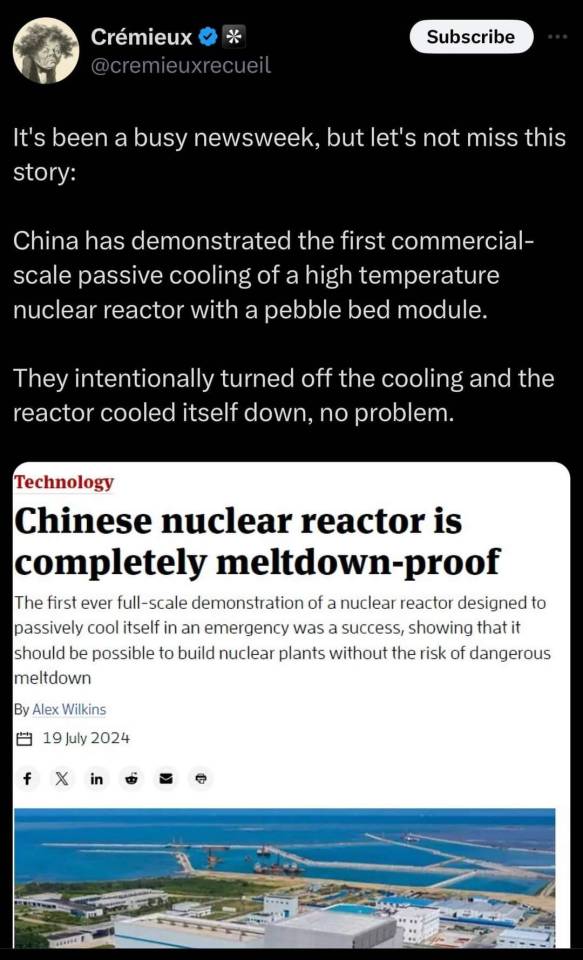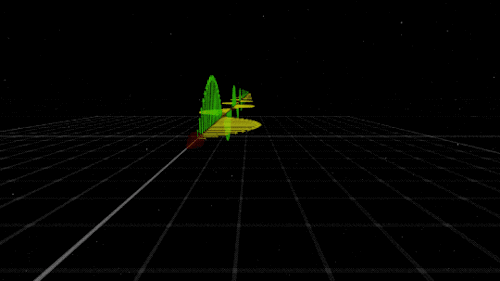Your personal Tumblr library awaits
Atoms - Blog Posts

I've recently been seeing this article making rounds around this website and particularly people misusing this very cool advancement to imply that modern nuclear reactors are "unsafe" or "dangerous", which is partially due to the just blatantly bad journalism on display here.
The accomplishment of this new reactor is definitely exceptionally impressive but I think that news websites (Even ones specializing in science) have been mischaracterizing the reactor as "meltdown-proof" which is just - wrong? and implies that current reactors are just begging to meltdown.
The cool thing about this new reactor is that its passively cooled, but that doesn't mean its INVULNERABLE to nuclear meltdowns, for example the Chernobyl meltdown happened completely independently of whether it was cooled passively or not.
In fact, passive cooling would only pose an advantage in situations where ALL pumps and backup pumps break and the core doesn't get coolant pumped to it. That's happened exactly once: in Fukushima and only after a literal tsunami hit it, and there's no reason to think that the passive Helium coolant in this new reactor wouldn't also just break. Fukushima happened because of corruption in regulation, preventing suitable defenses against this exact thing from getting built, not because of unsafe reactor design.
There's also some articles like this one which talk about the new reactor being "self-regulating" which is true, but misses the point that the vast majority of nuclear reactors in service today are also stable in the exact same way. Negative feedback loops are a HUGE part of reactor design, the most popular reactor design today is the Pressurised Water Reactor (PWR) which is incredibly stable - PWRs just truly hate increasing (or decreasing) energy output.
Most nuclear reactors today are already incredibly safe, even if you had complete control over a nuclear reactor it would be effectively impossible to cause a meltdown on purpose - both the physics of the system and the thousands of automated components would beat the ever loving shit out of any hope of trying to do so.
Articles like these just turn this impressive achievements into a kind of fearmongering over the "dangerous" nuclear reactors currently being used. The fact is that nuclear reactors are incredibly safe, PWRs are an incredible feat of engineering genius and its a genuine shame that the general public isn't aware of how much care goes into their design and safety, let alone how useful and essential they are in our electrical systems.
Modern nuclear reactors are clean, they are safe, and they are vital to a healthy energy grid in the post-fossil-fuel future.
A really good read I highly recommend is Colin Tucker's How To Drive A Nuclear Reactor. He's very clear and very frank with the workings and reality of nuclear power today.
We're just a bunch of atom's that can think.
May the Four Forces Be With You!
May the force be with you? Much to learn you still have, padawan. In our universe it would be more appropriate to say, “May the four forces be with you.”

There are four fundamental forces that bind our universe and its building blocks together. Two of them are easy to spot — gravity keeps your feet on the ground while electromagnetism keeps your devices running. The other two are a little harder to see directly in everyday life, but without them, our universe would look a lot different!
Let’s explore these forces in a little more detail.
Gravity: Bringing the universe together

If you jump up, gravity brings you back down to Earth. It also keeps the solar system together … and our galaxy, and our local group of galaxies and our supercluster of galaxies.
Gravity pulls everything together. Everything, from the bright centers of the universe to the planets farthest from them. In fact, you (yes, you!) even exert a gravitational force on a galaxy far, far away. A tiny gravitational force, but a force nonetheless.

Credit: NASA and the Advanced Visualization Laboratory at the National Center for Supercomputing and B. O'Shea, M. Norman
Despite its well-known reputation, gravity is actually the weakest of the four forces. Its strength increases with the mass of the two objects involved. And its range is infinite, but the strength drops off as the square of the distance. If you and a friend measured your gravitational tug on each other and then doubled the distance between you, your new gravitational attraction would just be a quarter of what it was. So, you have to be really close together, or really big, or both, to exert a lot of gravity.
Even so, because its range is infinite, gravity is responsible for the formation of the largest structures in our universe! Planetary systems, galaxies and clusters of galaxies all formed because gravity brought them together.
Gravity truly surrounds us and binds us together.
Electromagnetism: Lighting the way

You know that shock you get on a dry day after shuffling across the carpet? The electricity that powers your television? The light that illuminates your room on a dark night? Those are all the work of electromagnetism. As the name implies, electromagnetism is the force that includes both electricity and magnetism.
Electromagnetism keeps electrons orbiting the nucleus at the center of atoms and allows chemical compounds to form (you know, the stuff that makes up us and everything around us). Electromagnetic waves are also known as light. Once started, an electromagnetic wave will travel at the speed of light until it interacts with something (like your eye) — so it will be there to light up the dark places.

Like gravity, electromagnetism works at infinite distances. And, also like gravity, the electromagnetic force between two objects falls as the square of their distance. However, unlike gravity, electromagnetism doesn't just attract. Whether it attracts or repels depends on the electric charge of the objects involved. Two negative charges or two positive charges repel each other; one of each, and they attract each other. Plus. Minus. A balance.
This is what happens with common household magnets. If you hold them with the same “poles” together, they resist each other. On the other hand, if you hold a magnet with opposite poles together — snap! — they’ll attract each other.
Electromagnetism might just explain the relationship between a certain scruffy-looking nerf-herder and a princess.
Strong Force: Building the building blocks

Credit: Lawrence Livermore National Laboratory
The strong force is where things get really small. So small, that you can’t see it at work directly. But don’t let your eyes deceive you. Despite acting only on short distances, the strong force holds together the building blocks of the atoms, which are, in turn, the building blocks of everything we see around us.
Like gravity, the strong force always attracts, but that’s really where their similarities end. As the name implies, the force is strong with the strong force. It is the strongest of the four forces. It brings together protons and neutrons to form the nucleus of atoms — it has to be stronger than electromagnetism to do it, since all those protons are positively charged. But not only that, the strong force holds together the quarks — even tinier particles — to form those very protons and neutrons.
However, the strong force only works on very, very, very small distances. How small? About the scale of a medium-sized atom’s nucleus. For those of you who like the numbers, that’s about 10-15 meters, or 0.000000000000001 meters. That’s about a hundred billion times smaller than the width of a human hair! Whew.
Its tiny scale is why you don’t directly see the strong force in your day-to-day life. Judge a force by its physical size, do you?
Weak Force: Keeping us in sunshine

If you thought it was hard to see the strong force, the weak force works on even smaller scales — 1,000 times smaller. But it, too, is extremely important for life as we know it. In fact, the weak force plays a key role in keeping our Sun shining.
But what does the weak force do? Well … that requires getting a little into the weeds of particle physics. Here goes nothing! We mentioned quarks earlier — these are tiny particles that, among other things, make up protons and neutrons. There are six types of quarks, but the two that make up protons and neutrons are called up and down quarks. The weak force changes one quark type into another. This causes neutrons to decay into protons (or the other way around) while releasing electrons and ghostly particles called neutrinos.
So for example, the weak force can turn a down quark in a neutron into an up quark, which will turn that neutron into a proton. If that neutron is in an atom’s nucleus, the electric charge of the nucleus changes. That tiny change turns the atom into a different element! Such reactions are happening all the time in our Sun, giving it the energy to shine.
The weak force might just help to keep you in the (sun)light.

All four of these forces run strong in the universe. They flow between all things and keep our universe in balance. Without them, we’d be doomed. But these forces will be with you. Always.
You can learn more about gravity from NASA’s Space Place and follow NASAUniverse on Twitter or Facebook to learn about some of the cool cosmic objects we study with light.
Make sure to follow us on Tumblr for your regular dose of space: http://nasa.tumblr.com
I MADE AN ASCORBIC ACID! LOOK AT IT!!!
The shape of this is so awkward to hold when you’re trying to show the whole thing.




